Investigation of Natural and Human-Induced Landslides in Red Basaltic Soils
Abstract
1. Introduction
2. Materials and Methods
2.1. Field Investigation
2.2. Physical Properties Analysis
2.3. Real-Time Observations System
2.4. Slope Stability Analysis
3. Results
3.1. Investigation of the Landslide State
3.2. Physical Characteristic of the Soil Structure
3.3. Observation of Seasonal Water Table Variation and Soil Shear Strength Parameter Response
3.4. Rainfall-Mediated Slope Stability Analysis
3.5. Observation of Horizontal Displacement of the Soil Structure
3.6. Human Impacts on the Slope Stability
4. Discussion
4.1. Groundwater Level Facilitates the Slope Stability
4.2. Human Activities Enhances the Loss Slope Stability of the Red Basaltic Soil
4.3. Strain Gauge Sensor to Provide an Early Detect the Mass Movement
5. Conclusions
- -
- High intensity and frequency of rainfall regulate the shear strength parameters of the red basaltic soil that result in the instability of the hillslope;
- -
- Fluctuations in groundwater levels contribute to increased soil moisture, which, in turn, reduces shear strength parameters and destabilizes slopes;
- -
- Human-induced activities exacerbate the frequency of mass movement events. Common triggers include slope cutting for construction and cultivation on steep, vulnerable slopes. These activities increase external loading and promote water entrapment within the soil, thereby reducing slope stability.
- -
- Tilt sensor systems provide real-time data on groundwater levels and horizontal displacement at various depths. This technology forms a crucial component of early warning systems for multi-hazard risk management. In addition, integrating smart technologies and Internet of Things (IoT) solutions is highly beneficial for effective natural disaster management.
Supplementary Materials
Author Contributions
Funding
Data Availability Statement
Acknowledgments
Conflicts of Interest
References
- Varnes, D.J. Slope Movement Types and Processes; Special Report; National Academy of Sciences: Washington, DC, USA, 1978; Volume 176, pp. 11–33. [Google Scholar]
- Schuster, R.L.; Wieczorek, G.F. Landslide triggers and types. In Landslides; Routledge: London, UK, 2018; pp. 59–78. [Google Scholar] [CrossRef]
- Hungr, O.; Leroueil, S.; Picarelli, L. The Varnes classification of landslide types, an update. Landslides 2014, 11, 167–194. [Google Scholar] [CrossRef]
- Iverson, R.M. Landslide triggering by rain infiltration. Water Resour. Res. 2000, 36, 1897–1910. [Google Scholar] [CrossRef]
- Tohari, A. Study of rainfall-induced landslide: A review. IOP Conf. Ser. Earth Environ. Sci. 2018, 118, 012036. [Google Scholar] [CrossRef]
- Avanzi, G.D.A.; Giannecchini, R.; Puccinelli, A. The influence of the geological and geomorphological settings on shallow landslides. An example in a temperate climate environment: The June 19, 1996 event in northwestern Tuscany (Italy). Eng. Geol. 2004, 73, 215–228. [Google Scholar] [CrossRef]
- Angeli, M.-G.; Pasuto, A.; Silvano, S. A critical review of landslide monitoring experiences. Eng. Geol. 2000, 55, 133–147. [Google Scholar] [CrossRef]
- Hilker, N.; Badoux, A.; Hegg, C. The Swiss flood and landslide damage database 1972–2007. Nat. Hazards Earth Syst. Sci. 2009, 9, 913–925. [Google Scholar] [CrossRef]
- Vranken, L.; Van Turnhout, P.; Van Den Eeckhaut, M.; Vandekerckhove, L.; Poesen, J. Economic valuation of landslide damage in hilly regions: A case study from Flanders, Belgium. Sci. Total Environ. 2013, 447, 323–336. [Google Scholar] [CrossRef]
- Sheikh, M.R.; Nakata, Y.; Shitano, M.; Kaneko, M. Rainfall-induced unstable slope monitoring and early warning through tilt sensors. Soils Found. 2021, 61, 1033–1053. [Google Scholar] [CrossRef]
- Xia, D.; Zhao, B.; Liu, D.; Deng, Y.; Cheng, H.; Yan, Y.; Ding, S.; Cai, C. Effect of soil moisture on soil disintegration characteristics of different weathering profiles of collapsing gully in the hilly granitic region, South China. PLoS ONE 2018, 13, e0209427. [Google Scholar] [CrossRef]
- Saito, H.; Nakayama, D.; Matsuyama, H. Relationship between the initiation of a shallow landslide and rainfall intensity—Duration thresholds in Japan. Geomorphology 2010, 118, 167–175. [Google Scholar] [CrossRef]
- Korup, O. Rock type leaves topographic signature in landslide-dominated mountain ranges. Geophys. Res. Lett. 2008, 35. [Google Scholar] [CrossRef]
- Tohari, A.; Nishigaki, M.; Komatsu, M. Laboratory rainfall-induced slope failure with moisture content measurement. J. Geotech. Geoenviron. Eng. 2007, 133, 575–587. [Google Scholar] [CrossRef]
- Zong, H.; Dai, Q.; Zhu, J. Ensemble Predictions of Rainfall-Induced Landslide Risk under Climate Change in China Integrating Antecedent Soil-Wetness Factors. Atmosphere 2024, 15, 1013. [Google Scholar] [CrossRef]
- Salmi, E.F.; Nazem, M.; Karakus, M. Numerical analysis of a large landslide induced by coal mining subsidence. Eng. Geol. 2017, 217, 141–152. [Google Scholar] [CrossRef]
- Sharma, A.; Sajjad, H.; Roshani; Rahaman, M.H. A systematic review for assessing the impact of climate change on landslides: Research gaps and directions for future research. Spat. Inf. Res. 2024, 32, 165–185. [Google Scholar] [CrossRef]
- Corominas, J.; Moya, J. A review of assessing landslide frequency for hazard zoning purposes. Eng. Geol. 2008, 102, 193–213. [Google Scholar] [CrossRef]
- Ko, F.W.Y.; Lo, F.L.C. From landslide susceptibility to landslide frequency: A territory-wide study in Hong Kong. Eng. Geol. 2018, 242, 12–22. [Google Scholar] [CrossRef]
- Tanyaş, H.; van Westen, C.J.; Allstadt, K.E.; Jibson, R.W. Factors controlling landslide frequency–area distributions. Earth Surf. Process. Landf. 2019, 44, 900–917. [Google Scholar] [CrossRef]
- Guthrie, R.H.; Evans, S. Analysis of landslide frequencies and characteristics in a natural system, coastal British Columbia. Earth Surf. Process. Landf. J. Br. Geomorphol. Res. Group 2004, 29, 1321–1339. [Google Scholar] [CrossRef]
- Regmi, A.D.; Yoshida, K.; Dhital, M.R.; Devkota, K. Effect of rock weathering, clay mineralogy, and geological structures in the formation of large landslide, a case study from Dumre Besei landslide, Lesser Himalaya Nepal. Landslides 2013, 10, 1–13. [Google Scholar] [CrossRef]
- Vingiani, S.; Terribile, F.; Meunier, A.; Petit, S. Weathering of basaltic pebbles in a red soil from Sardinia: A microsite approach for the identification of secondary mineral phases. CATENA 2010, 83, 96–106. [Google Scholar] [CrossRef]
- Dessert, C.; Dupré, B.; Gaillardet, J.; François, L.M.; Allègre, C.J. Basalt weathering laws and the impact of basalt weathering on the global carbon cycle. Chem. Geol. 2003, 202, 257–273. [Google Scholar] [CrossRef]
- Duong, N.A.; Nam, K.Q.; Anh, T.T. Red basaltic soils-the raw material source for production of non-calcined brick. Vietnam J. Earth Sci. 2014, 36, 214–220. [Google Scholar] [CrossRef]
- Cole, T.L.; Torres, M.A.; Kemeny, P.C. The hydrochemical signature of incongruent weathering in Iceland. J. Geophys. Res. Earth Surf. 2022, 127, e2021JF006450. [Google Scholar] [CrossRef]
- Meunier, A.; Sardini, P.; Robinet, J.; Prêt, D. The petrography of weathering processes: Facts and outlooks. Clay Miner. 2007, 42, 415–435. [Google Scholar] [CrossRef]
- Thủy, N.T.; Anh, L.T. Đánh giá chất lượng ất bazan dưới các loại hình sử dụng ất khác nhau khu vực Di Linh-Bảo Lộc, tỉnh Lâm Đồng. VNU J. Sci.-Earth Environ. Stud. 2017, 33. [Google Scholar] [CrossRef][Green Version]
- Yu, H.; Huang, X.; Ning, J.; Zhu, B.; Cheng, Y. Effect of cation exchange capacity of soil on stabilized soil strength. Soils Found. 2014, 54, 1236–1240. [Google Scholar] [CrossRef]
- Skempton, A.W. Residual strength of clays in landslides, folded strata and the laboratory. Geotechnique 1985, 35, 3–18. [Google Scholar] [CrossRef]
- Skempton, A. The colloidal activity of clays. Sel. Pap. Soil Mech. 1953, 1, 57–61. [Google Scholar]
- Tuncer, E.R.; Lohnes, R.A. An engineering classification for certain basalt-derived lateritic soils. Eng. Geol. 1977, 11, 319–339. [Google Scholar] [CrossRef]
- Sun, L.; Ma, B.; Pei, L.; Zhang, X.; Zhou, J.L. The relationship of human activities and rainfall-induced landslide and debris flow hazards in Central China. Nat. Hazards 2021, 107, 147–169. [Google Scholar] [CrossRef]
- Olim, D.; Afu, S.; Ediene, V.; Uko, I.; Akpa, E. Morphological and physicochemical properties of basaltic soils on a toposequence in Ikom, South Eastern Nigeria. World News Nat. Sci. 2019, 84–92. [Google Scholar] [CrossRef]
- Baum, R.L.; Wieczorek, G.F. Landslide investigation methods. In Landslide and Land Subsidence Hazards to Pipelines; US Geological Survey: Reston, VA, USA, 2008. [Google Scholar]
- Mburu, J.W.; Li, A.-J.; Lin, H.-D.; Lu, C.-W. Investigations of unsaturated slopes subjected to rainfall infiltration using numerical approaches—A parametric study and comparative review. Sustainability 2022, 14, 14465. [Google Scholar] [CrossRef]
- Bishop, A.W. The use of the slip circle in the stability analysis of slopes. Geotechnique 1955, 5, 7–17. [Google Scholar] [CrossRef]
- Cai, F.; Ugai, K. Numerical analysis of rainfall effects on slope stability. Int. J. Geomech. 2004, 4, 69–78. [Google Scholar] [CrossRef]
- Ng, C.W.W.; Shi, Q. A numerical investigation of the stability of unsaturated soil slopes subjected to transient seepage. Comput. Geotech. 1998, 22, 1–28. [Google Scholar] [CrossRef]
- Thanh, D.Q.; Nguyen, D.H.; Prakash, I.; Jaafari, A.; Nguyen, V.-T.; Van Phong, T.; Pham, B.T. GIS based frequency ratio method for landslide susceptibility mapping at Da Lat City, Lam Dong province, Vietnam. Vietnam J. Earth Sci. 2020, 42, 55–66. [Google Scholar] [CrossRef]
- Nguyen, T.T.B.; Satir, M.; Siebel, W.; Chen, F. Granitoids in the Dalat zone, southern Vietnam: Age constraints on magmatism and regional geological implications. Int. J. Earth Sci. 2004, 93, 329–340. [Google Scholar] [CrossRef]
- Shellnutt, J.G.; Lan, C.-Y.; Van Long, T.; Usuki, T.; Yang, H.-J.; Mertzman, S.A.; Iizuka, Y.; Chung, S.-L.; Wang, K.-L.; Hsu, W.-Y. Formation of Cretaceous Cordilleran and post-orogenic granites and their microgranular enclaves from the Dalat zone, southern Vietnam: Tectonic implications for the evolution of Southeast Asia. Lithos 2013, 182, 229–241. [Google Scholar] [CrossRef]
- Vladimirov, A.; Phan, L.; Travin, A.; Mikheev, E.; Murzintsev, N.; Annikova, I.Y. The geology and thermochronology of Cretaceous magmatism of southeastern Vietnam. Russ. J. Pac. Geol. 2020, 14, 305–325. [Google Scholar] [CrossRef]
- McCoy, E.; Cardina, J. Characterizing the structure of undisturbed soils. Soil Sci. Soc. Am. J. 1997, 61, 280–286. [Google Scholar] [CrossRef]
- Shen, D.; Shi, Z.; Zheng, H.; Yang, J.; Hanley, K.J. Effects of grain composition on the stability, breach process, and breach parameters of landslide dams. Geomorphology 2022, 413, 108362. [Google Scholar] [CrossRef]
- Yalcin, A. The effects of clay on landslides: A case study. Appl. Clay Sci. 2007, 38, 77–85. [Google Scholar] [CrossRef]
- Temme, A.J. Relations between soil d1velopment and landslides. In Hydrogeology, Chemical Weathering, and Soil Formation; Wiley: Hoboken, NJ, USA, 2021; pp. 177–185. [Google Scholar] [CrossRef]
- Zhang, Z.; Zeng, R.; Meng, X.; Zhao, S.; Wang, S.; Ma, J.; Wang, H. Effects of changes in soil properties caused by progressive infiltration of rainwater on rainfall-induced landslides. Catena 2023, 233, 107475. [Google Scholar] [CrossRef]
- Marciano Jr, J.S.; Zarco, M.A.H.; Talampas, M.C.R.; Catane, S.G.; Hilario, C.G.; Zabanal, M.A.B.; Carreon, C.R.C.; Mendoza, E.A.; Kaimo, R.N.; Cordero, C.N. Real-world deployment of a locally-developed tilt and moisture sensor for landslide monitoring in the Philippines. In Proceedings of the 2011 IEEE Global Humanitarian Technology Conference, Seattle, WA, USA, 30 October–1 November 2011; pp. 344–349. [Google Scholar] [CrossRef]
- Zet, C.; Foşalău, C.; Petrişor, D. Pore water pressure sensor for landslide prediction. In Proceedings of the 2015 IEEE SENSORS, Busan, Republic of Korea, 1–4 November 2015; pp. 1–4. [Google Scholar] [CrossRef]
- Fondjo, A.A.; Theron, E.; Ray, R.P. Evaluation of the unsaturated shear strength parameters of compacted, heaving soil using geotechnical properties. E3S Web Conf. 2023, 382, 02002. [Google Scholar] [CrossRef]
- Ali, T.; Rana, H.; Babu, G.S. Analysis of rainfall-induced shallow slope failure. In Proceedings of the Indian Geotechnical Conference 2019, Kochi, India, 15–17 December 2019; IGC-2019 Volume I. Springer: Singapore, 2021; pp. 679–691. [Google Scholar] [CrossRef]
- Ahmad, R.; Mardhanie, A.; Suroso, P.; Sutarto, T.; Alfajri, R. Effect of groundwater table on slope stability and design of retaining wall. J. Phys. Conf. Ser. 2020, 1500, 012072. [Google Scholar] [CrossRef]
- Shen, Q.; Zhang, Y.; Yan, Y.; Dong, H.; Lei, W. Experimental Study on Infiltration Characteristics of Shallow Rainwater in Expansive Soil Slopes at Different Gradients. Water 2025, 17, 642. [Google Scholar] [CrossRef]
- Gu, X.; Song, L.; Xia, X.; Yu, C. Finite Element Method-Peridynamics Coupled Analysis of Slope Stability Affected by Rainfall Erosion. Water 2024, 16, 2210. [Google Scholar] [CrossRef]
- Wang, M.; Li, L. Slope Stability Analysis Considering Degradation of Soil Properties Induced by Intermittent Rainfall. Water 2025, 17, 814. [Google Scholar] [CrossRef]
- Hussain, R.; Ravi, K.; Garg, A. Influence of biochar on the soil water retention characteristics (SWRC): Potential application in geotechnical engineering structures. Soil Tillage Res. 2020, 204, 104713. [Google Scholar] [CrossRef]
- Mair, A.; Fares, A. Influence of groundwater pumping and rainfall spatio-temporal variation on streamflow. J. Hydrol. 2010, 393, 287–308. [Google Scholar] [CrossRef]
- Liang, Z.; Chen, X.; Wang, C.; Zhang, Z. Response of Soil Moisture to Four Rainfall Regimes and Tillage Measures under Natural Rainfall in Red Soil Region, Southern China. Water 2024, 16, 1331. [Google Scholar] [CrossRef]
- Wang, Y.; Gao, L.; Li, J.; Peng, X. Responses of deep soil moisture to direct rainfall and groundwater in the red soil critical zone: A four-stage pattern. J. Hydrol. 2024, 632, 130864. [Google Scholar] [CrossRef]
- Eltahir, E.A. A soil moisture–rainfall feedback mechanism: 1. Theory and observations. Water Resour. Res. 1998, 34, 765–776. [Google Scholar] [CrossRef]
- Ogawa, S.; Ikeda, T.; Kamei, T.; Wada, T. Field Investigations on Seasonal Variations of the Groundwater Level and Pore Water Pressure in Landslide Areas. Soils Found. 1987, 27, 50–60. [Google Scholar] [CrossRef][Green Version]
- Yüksek, S.; Şenol, A. Groundwater Level Estimation for Slope Stability Analysis of a Coal Open Pit Mine. Civ. Eng. Res. J. 2021, 12. [Google Scholar] [CrossRef]
- Ravindran, S.; Gratchev, I. Effect of Water Content on Apparent Cohesion of Soils from Landslide Sites. Geotechnics 2022, 2, 385–394. [Google Scholar] [CrossRef]
- Liu, X.; Chen, X.; Su, M.; Zhang, S.; Lu, D. Stability Analysis of a Weathered-Basalt Soil Slope Using the Double Strength Reduction Method. Adv. Civ. Eng. 2021, 2021, 6640698. [Google Scholar] [CrossRef]
- Zhang, D.; Wei, K.; Yao, Y.; Yang, J.; Zheng, G.; Li, Q. Capture and prediction of rainfall-induced landslide warning signals using an attention-based temporal convolutional neural network and entropy weight methods. Sensors 2022, 22, 6240. [Google Scholar] [CrossRef]
- Guo, L.; Chen, G.; Gong, S.; Sun, H.; Chantat, K. Analysis of Rainfall-induced Landslide Using the Extended DDA by Incorporating Matric Suction. Comput. Geotech. 2021, 135, 104145. [Google Scholar] [CrossRef]
- Sibala, E.; Langkoke, R. Determination of safety factor value of PIT design based on cohesion and friction angle. IOP Conf. Ser. Earth Environ. Sci. 2019, 235, 012084. [Google Scholar] [CrossRef]
- Lu, L.; Wang, Z.; Song, M.; Arai, K. Stability analysis of slopes with ground water during earthquakes. Eng. Geol. 2015, 193, 288–296. [Google Scholar] [CrossRef]
- Laimer, H.J. Anthropogenically induced landslides—A challenge for railway infrastructure in mountainous regions. Eng. Geol. 2017, 222, 92–101. [Google Scholar] [CrossRef]
- Malgot, J.; Baliak, F. The influence of human activity on the development of landslides in Slovakia. Geogr. Cas. Slov. Akad. Vied 2002, 54, 21–38. [Google Scholar]
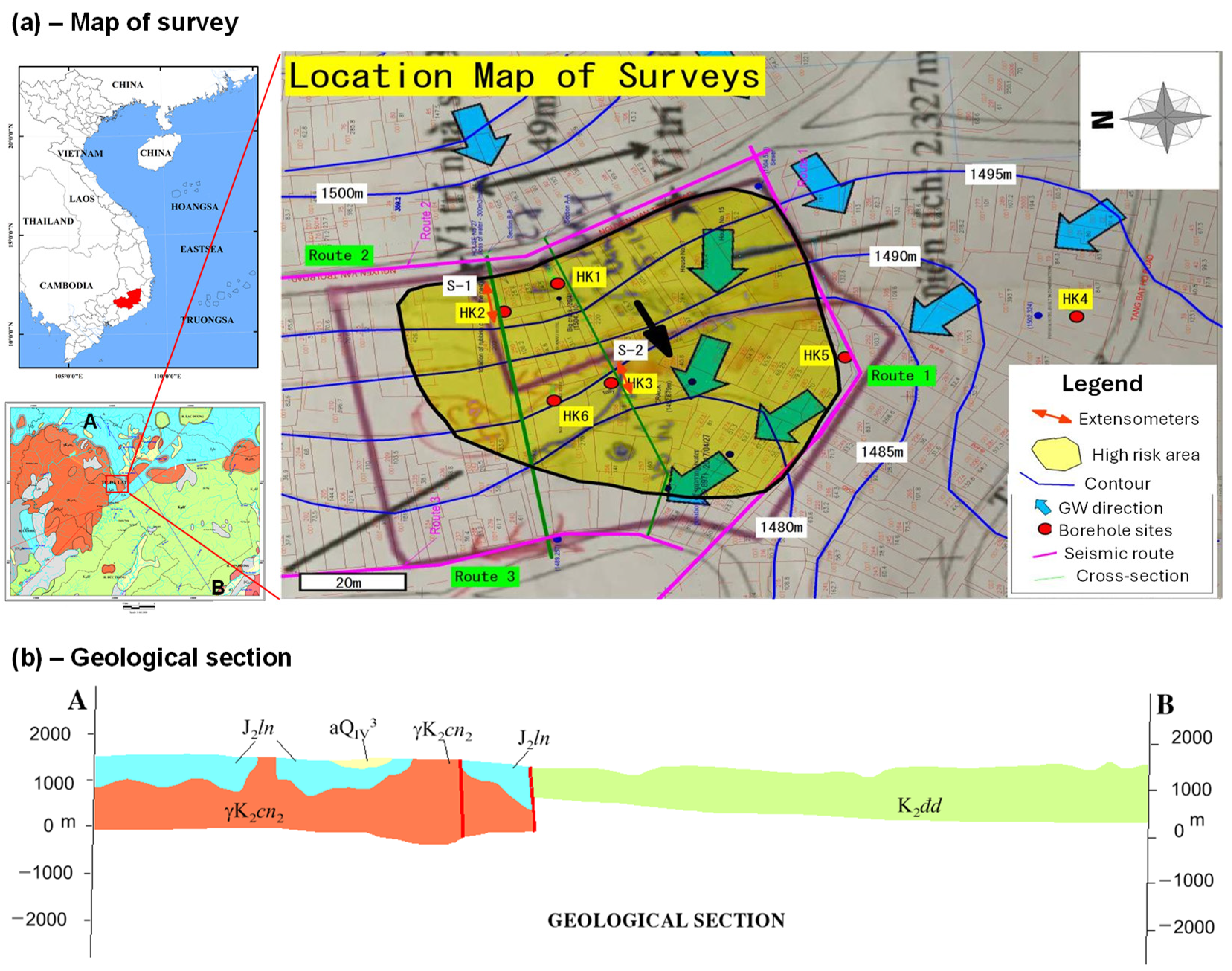
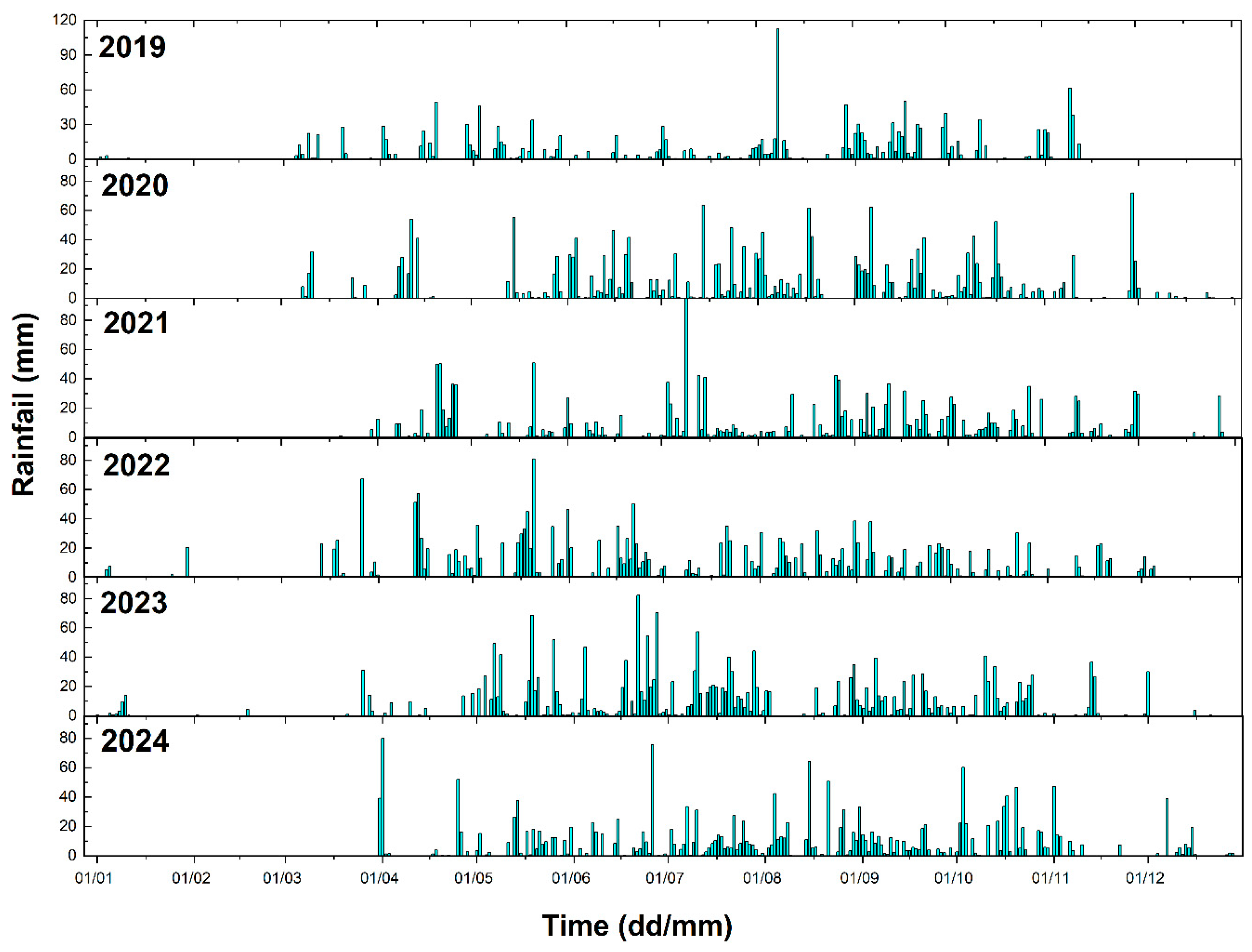
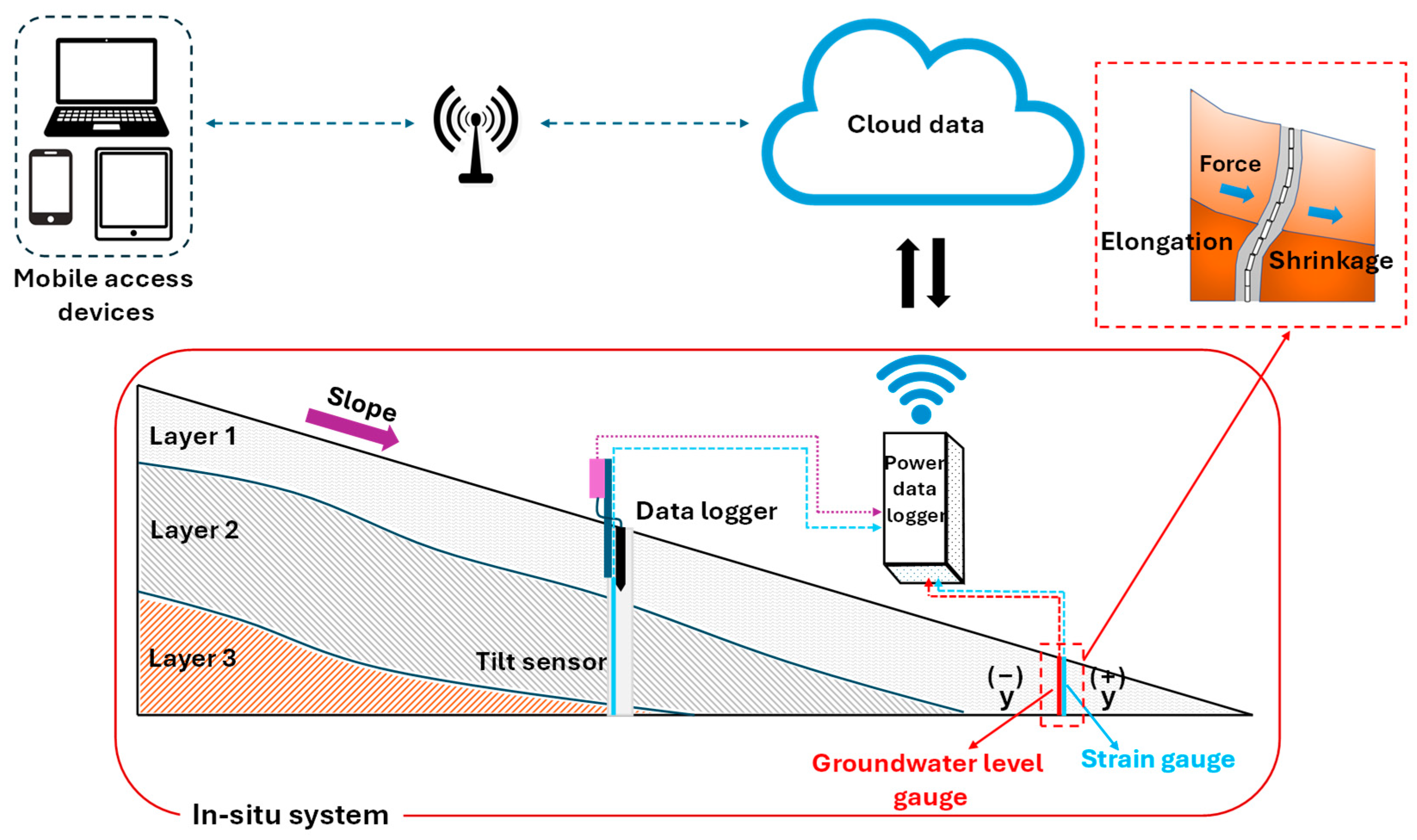

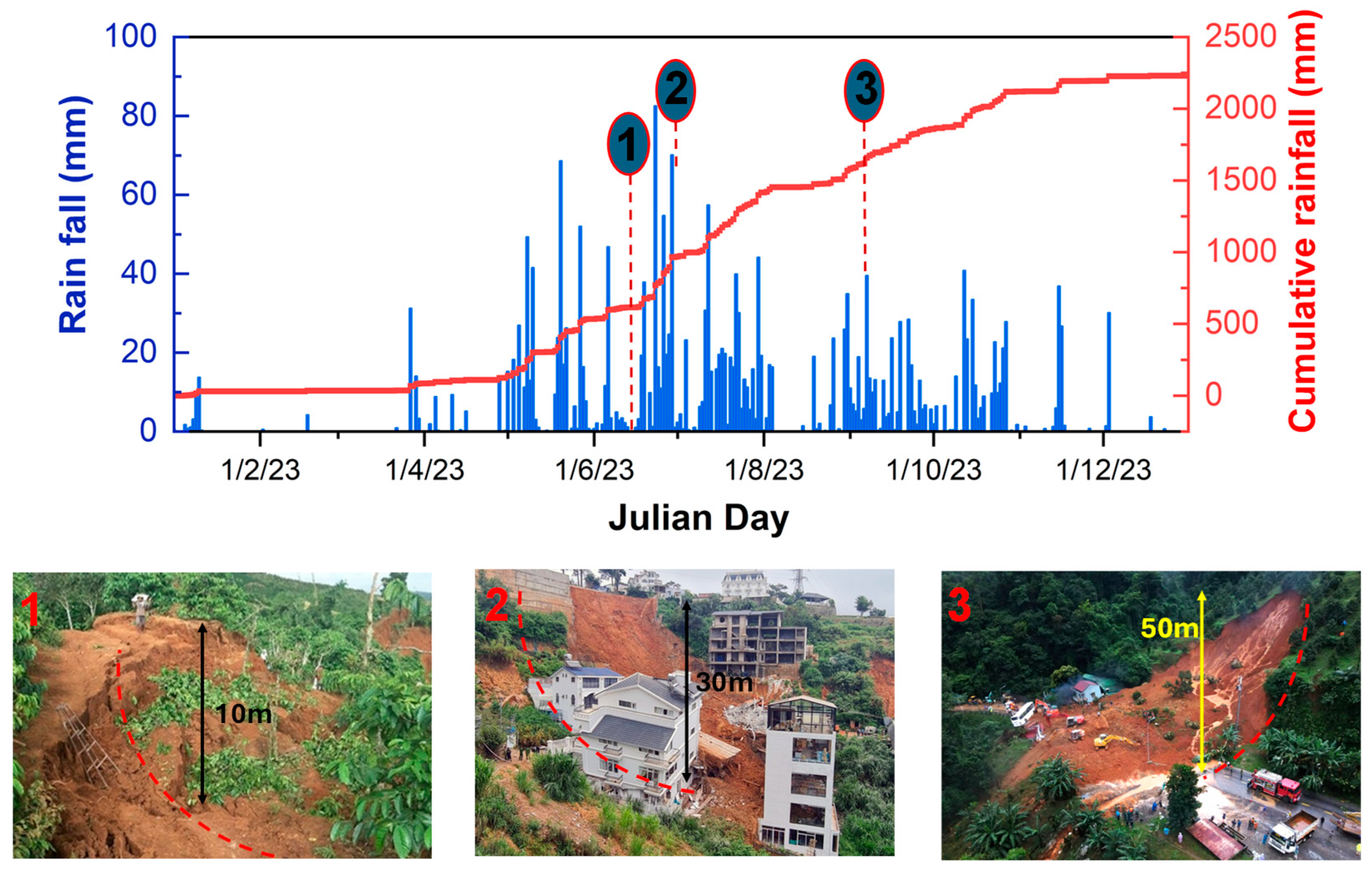
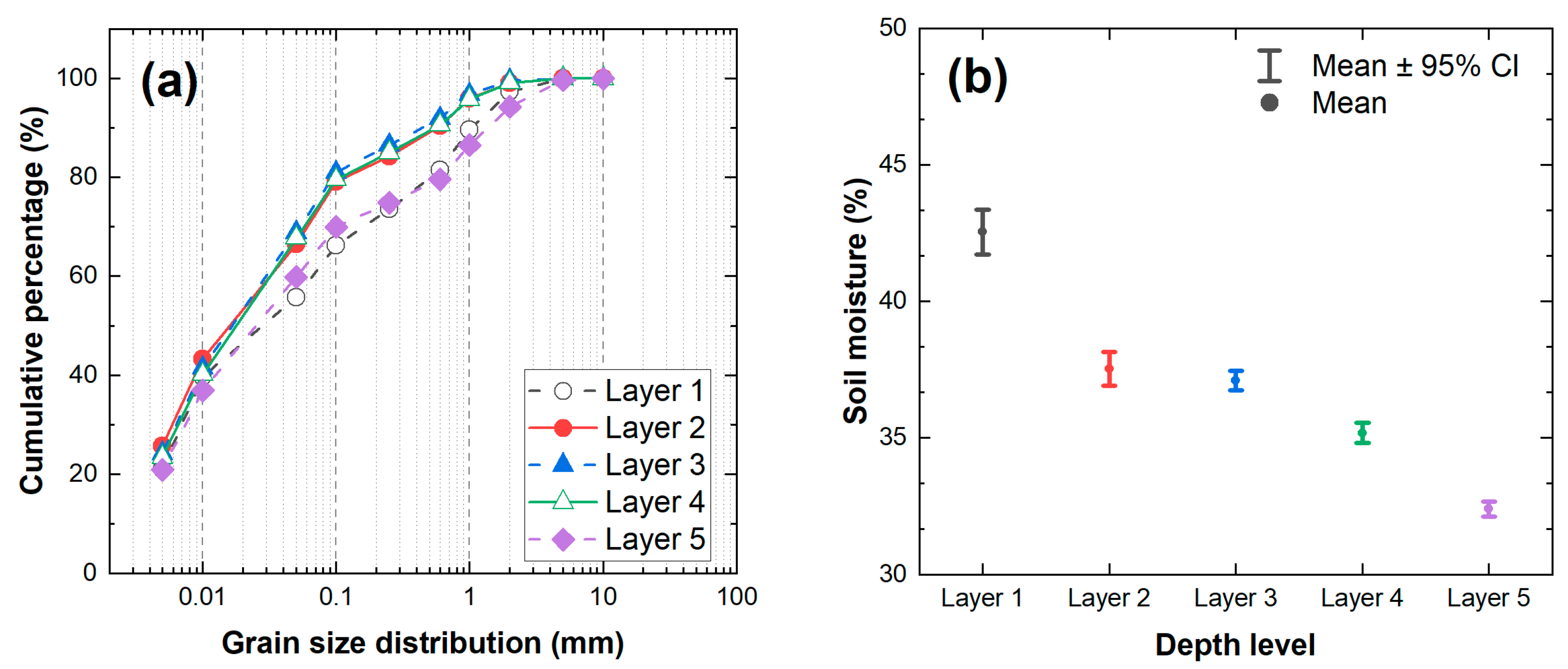
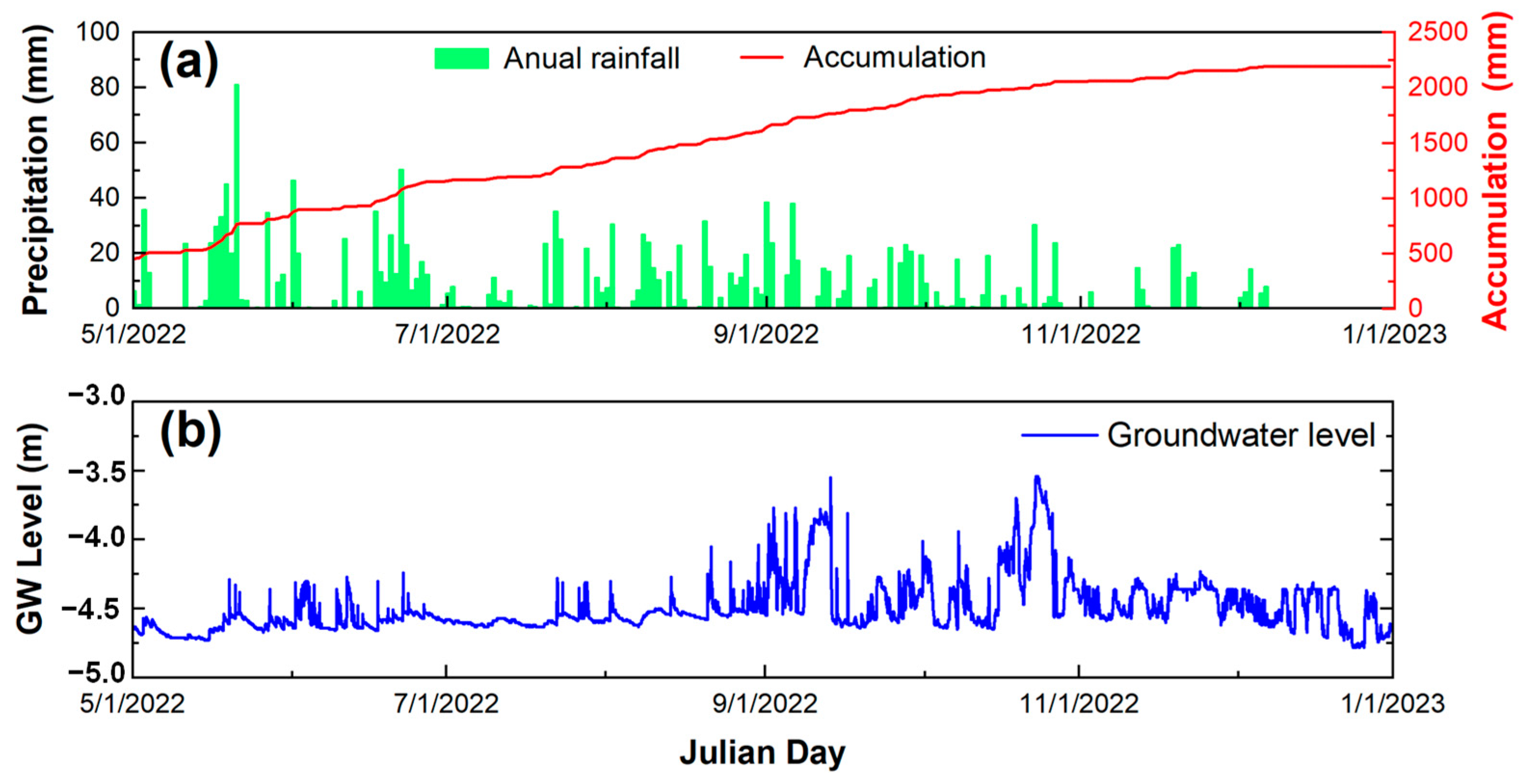
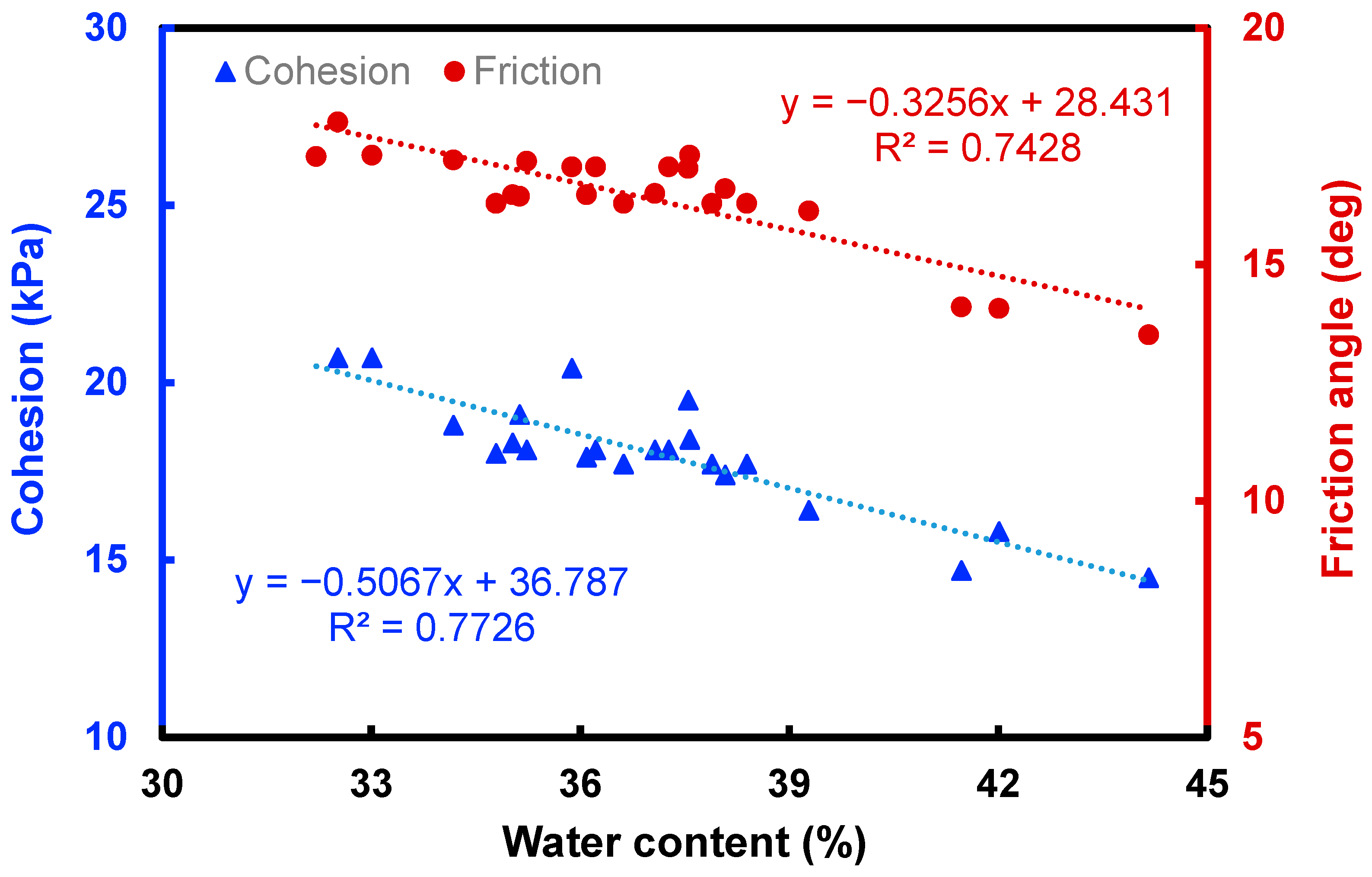
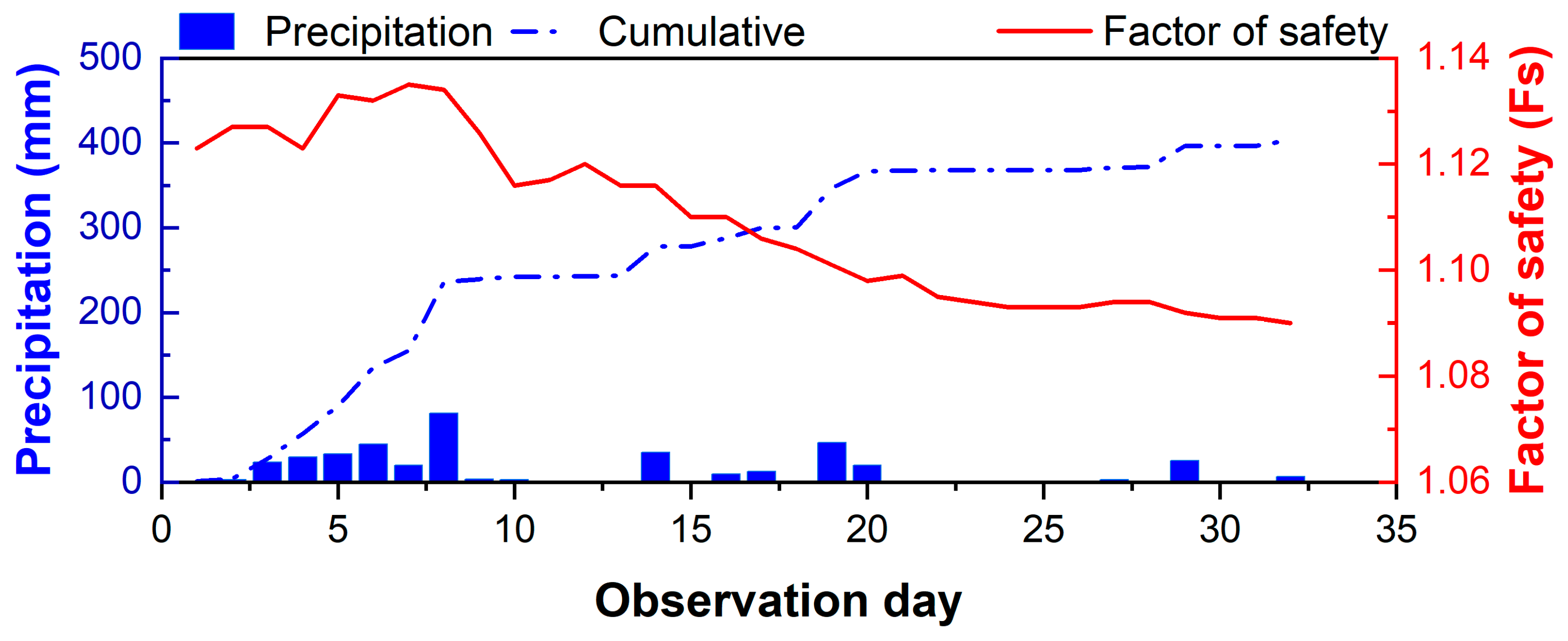
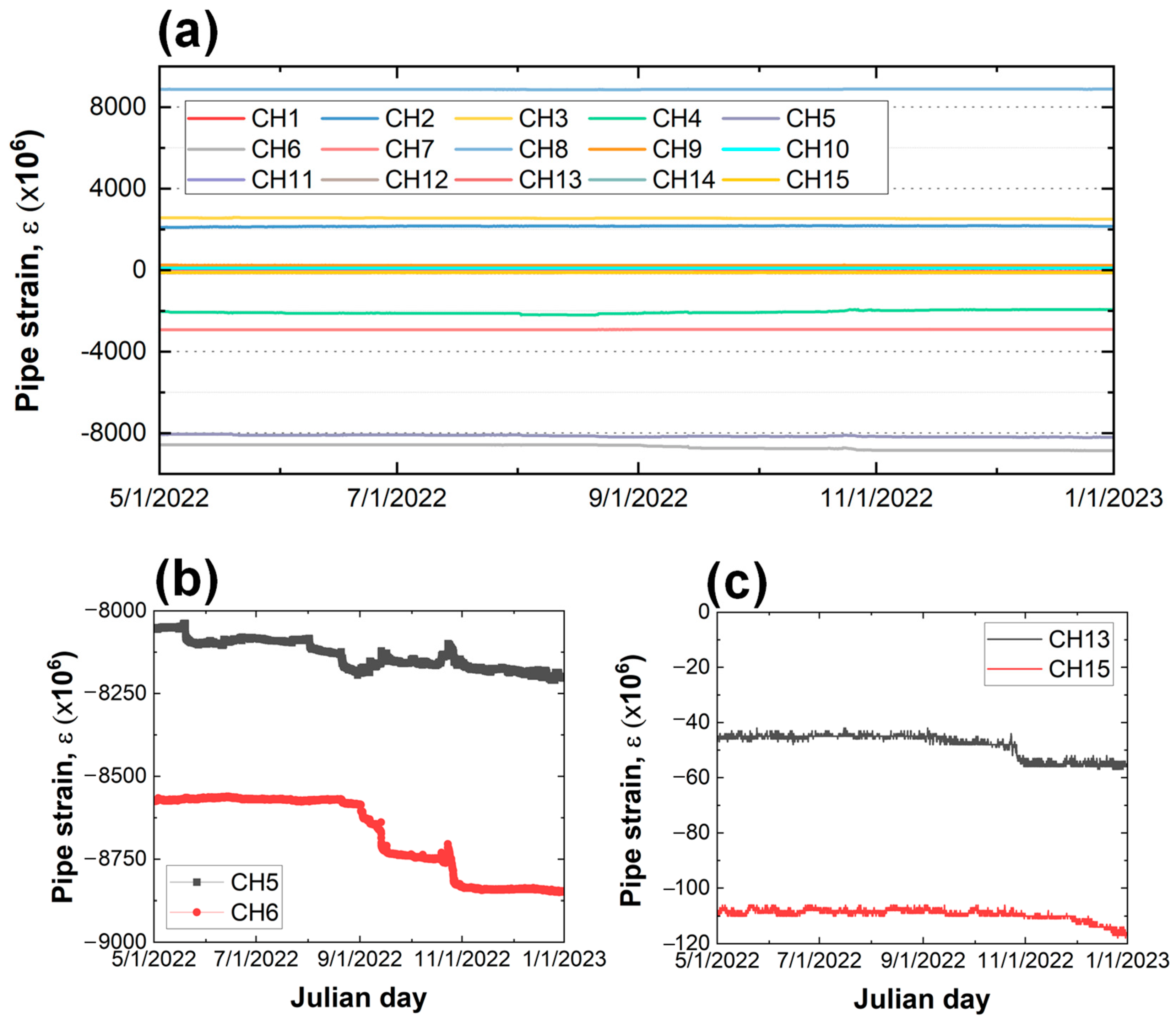
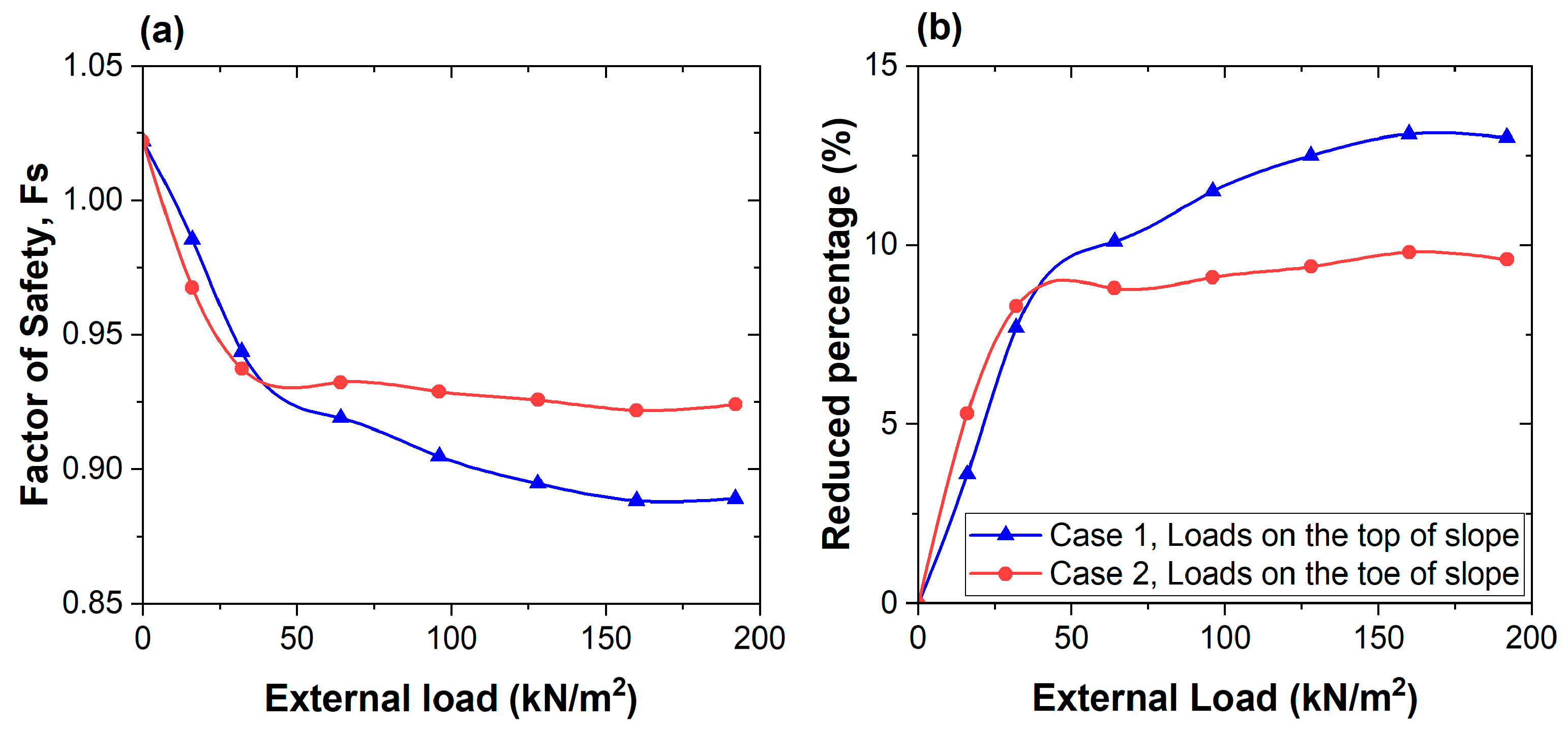
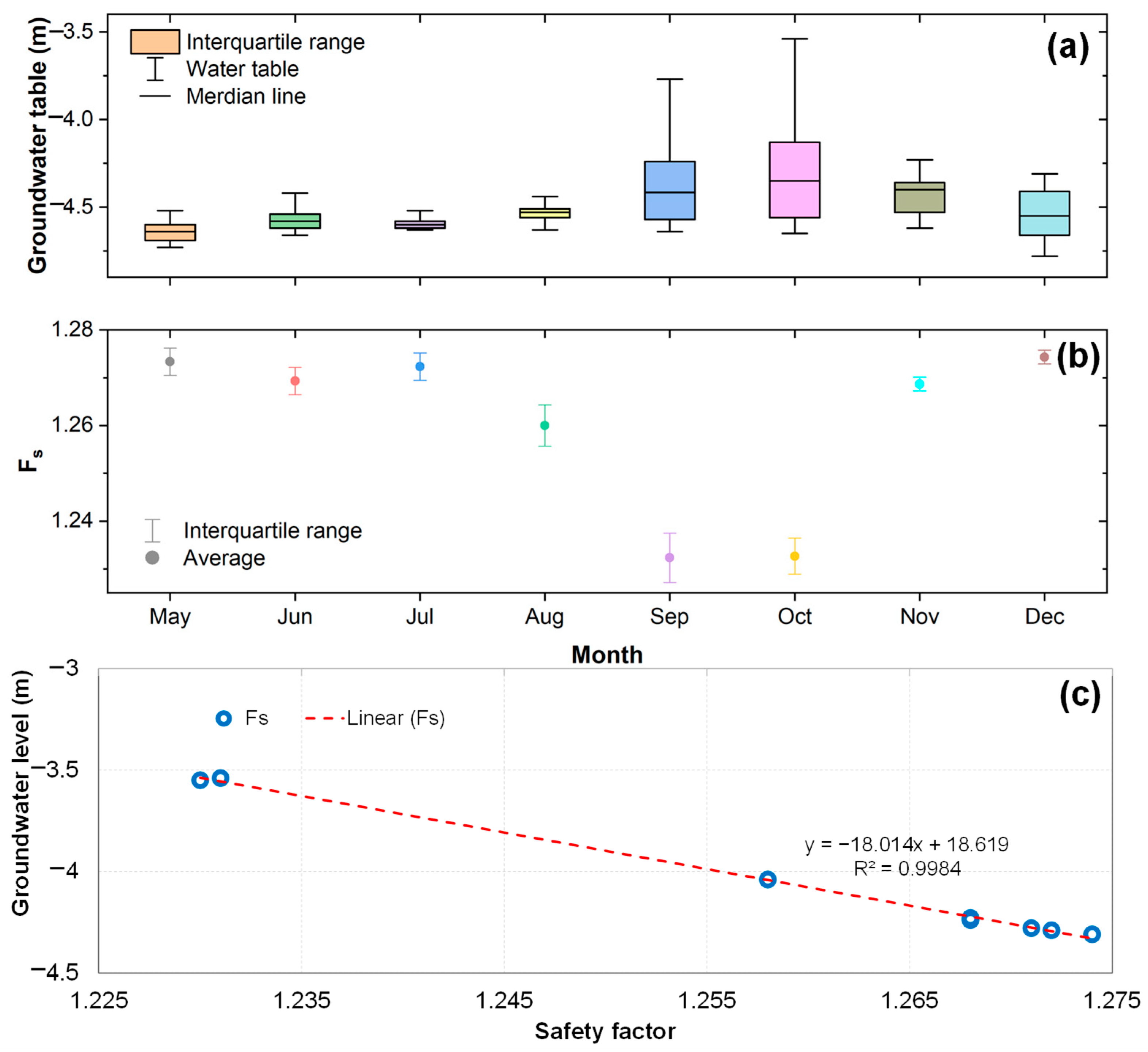
| Parameters | Unit | Layer 1 | Layer 2 | Layer 3 | Layer 4 | Layer 5 |
|---|---|---|---|---|---|---|
| kN/m3 | 17.4 | 17.8 | 17.9 | 18.1 | 18.4 | |
| kN/m3 | 17.7 | 18.3 | 18.3 | 18.5 | 18.8 | |
| kN/m2 | 3379 | 4049 | 4150 | 4529 | 5045 | |
| - | 0.2 | 0.2 | 0.2 | 0.2 | 0.2 | |
| kN/m2 | 15.0 | 18.0 | 17.9 | 19.1 | 21.6 | |
| o | 14.03 | 16.45 | 16.49 | 17.03 | 17.41 | |
| m/d | From grain size distribution | |||||
| m/d | ||||||
| Layer/ Depth (m) | Natural Gravity (g/cm3) | Water Content (%) | Void Ratio (%) | Liquid Limit (%) | Plastic Limit (%) | Plasticity Index | Cohesion (kPa) | Friction Angle (°) |
|---|---|---|---|---|---|---|---|---|
| Layer 1 (−1.0) | 1.74 | 41.47 | 54.78 | 45.71 | 34.09 | 11.62 | 14.7 | 14.1 |
| Layer 2 (−3.0) | 1.79 | 37.55 | 53.06 | 47.84 | 32.29 | 15.55 | 19.5 | 17.03 |
| Layer 3 (−6.2) | 1.77 | 37.27 | 53 | 47.08 | 33.01 | 14.07 | 18.1 | 17.06 |
| Layer 4 (−12.2) | 1.81 | 34.79 | 51.03 | 44.85 | 32.13 | 12.72 | 18 | 16.29 |
| Layer 5 (−20.0) | 1.83 | 33.01 | 49.42 | 43.89 | 32.81 | 11.08 | 20.7 | 17.31 |
Disclaimer/Publisher’s Note: The statements, opinions and data contained in all publications are solely those of the individual author(s) and contributor(s) and not of MDPI and/or the editor(s). MDPI and/or the editor(s) disclaim responsibility for any injury to people or property resulting from any ideas, methods, instructions or products referred to in the content. |
© 2025 by the authors. Licensee MDPI, Basel, Switzerland. This article is an open access article distributed under the terms and conditions of the Creative Commons Attribution (CC BY) license (https://creativecommons.org/licenses/by/4.0/).
Share and Cite
Nguyen, H.S.; Khau, T.L.; Huynh, T.T. Investigation of Natural and Human-Induced Landslides in Red Basaltic Soils. Water 2025, 17, 1320. https://doi.org/10.3390/w17091320
Nguyen HS, Khau TL, Huynh TT. Investigation of Natural and Human-Induced Landslides in Red Basaltic Soils. Water. 2025; 17(9):1320. https://doi.org/10.3390/w17091320
Chicago/Turabian StyleNguyen, Huu Son, Thi Ly Khau, and Trung Tin Huynh. 2025. "Investigation of Natural and Human-Induced Landslides in Red Basaltic Soils" Water 17, no. 9: 1320. https://doi.org/10.3390/w17091320
APA StyleNguyen, H. S., Khau, T. L., & Huynh, T. T. (2025). Investigation of Natural and Human-Induced Landslides in Red Basaltic Soils. Water, 17(9), 1320. https://doi.org/10.3390/w17091320






